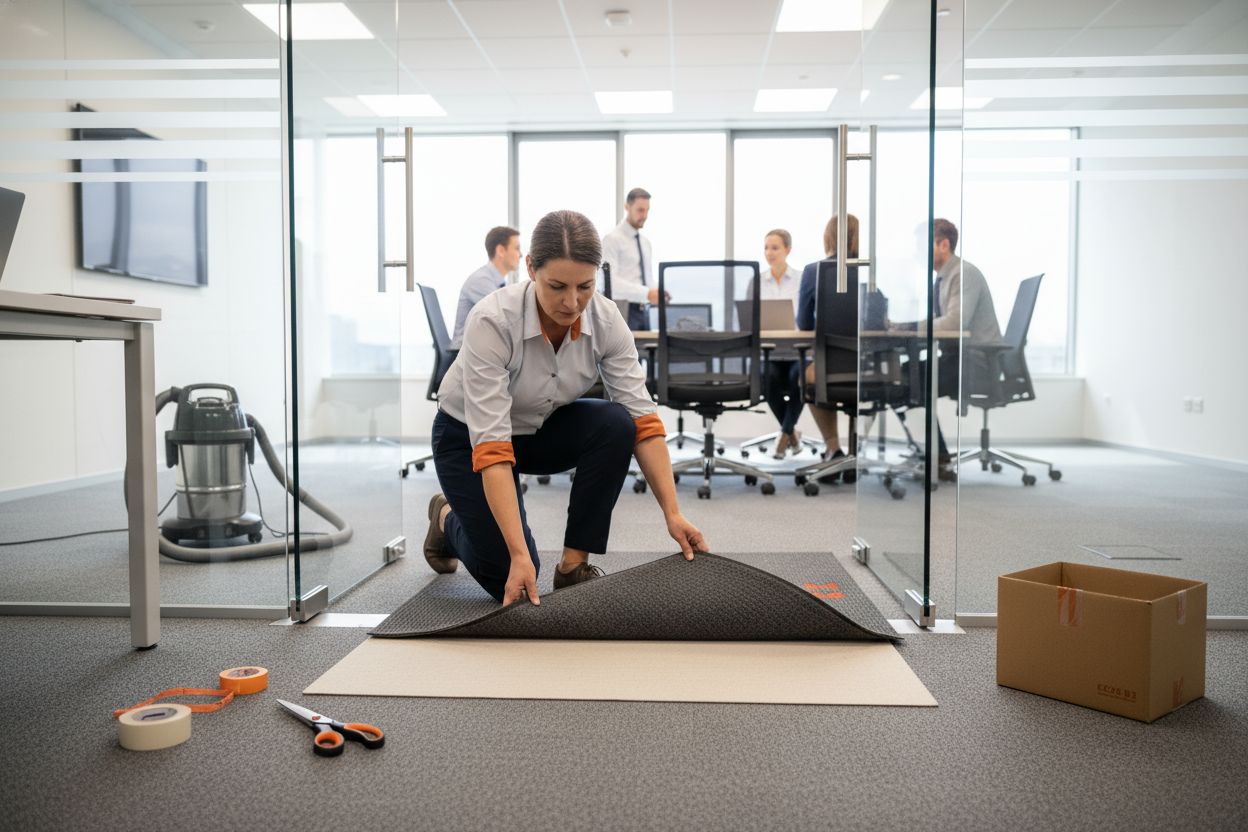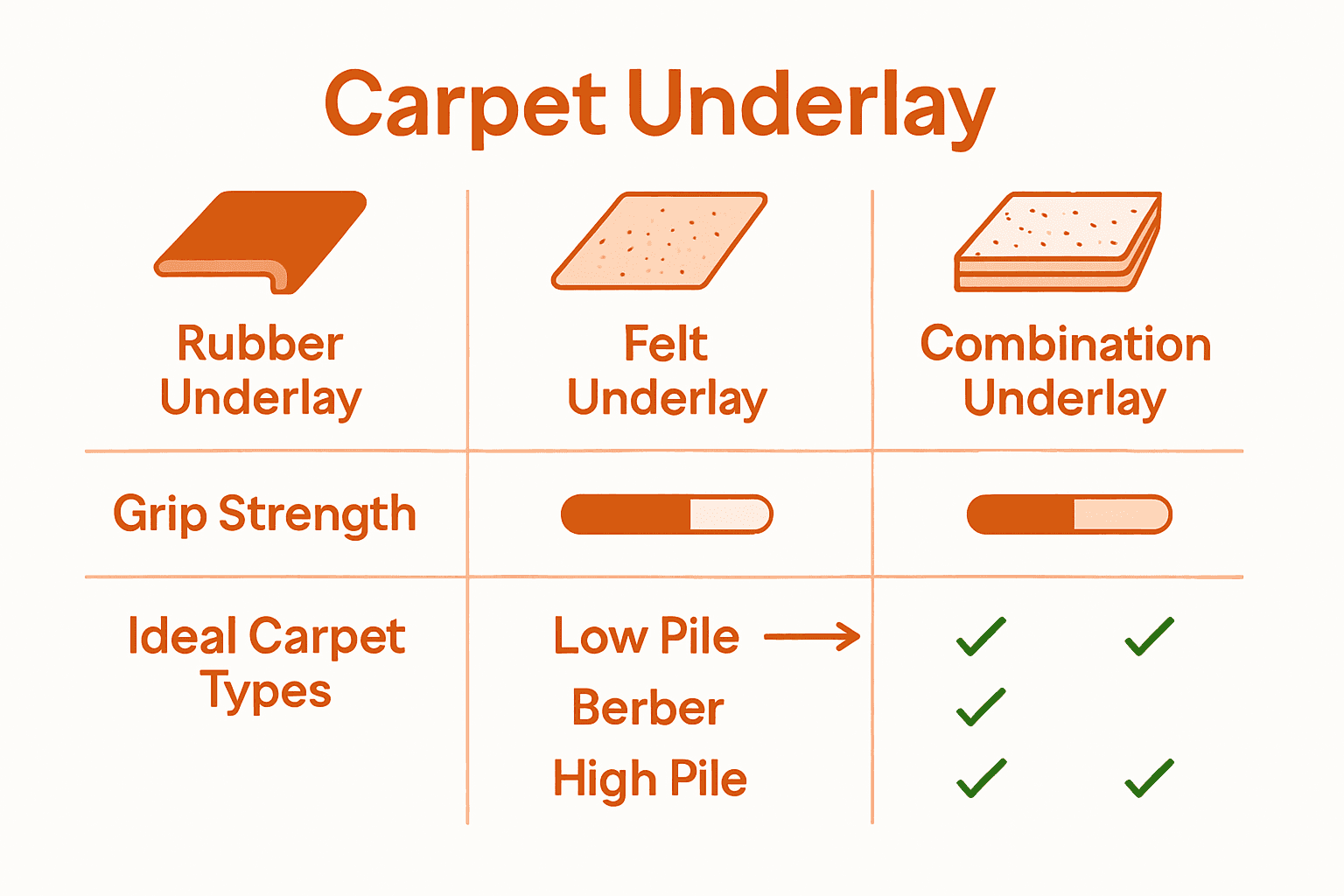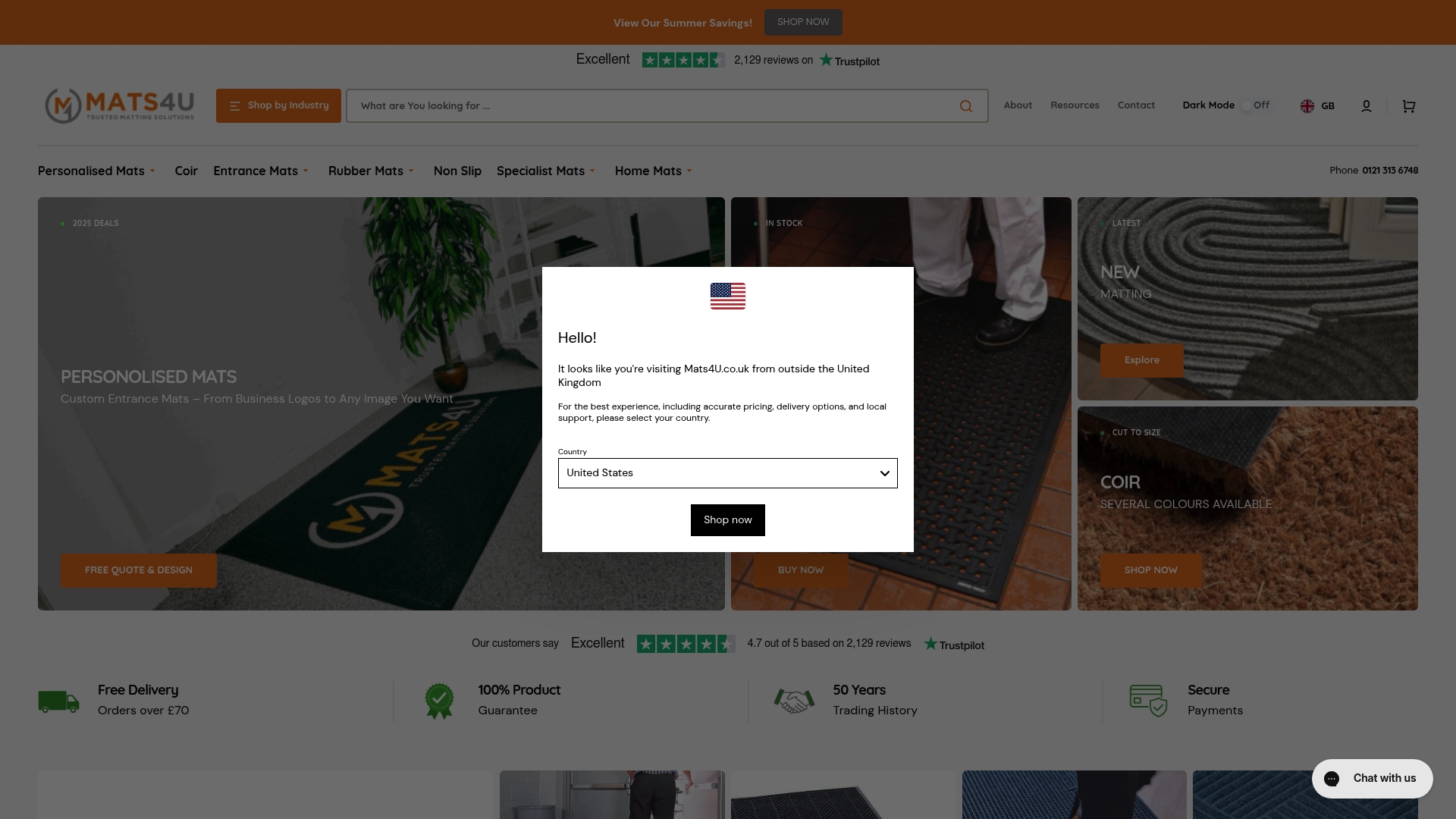Did you know that slips and trips cost UK businesses over £500 million every year? Keeping mats securely in place on carpet is more than a matter of appearance. It protects staff and visitors while maintaining a professional workspace. With the right preparation and materials, you can dramatically reduce movement and prevent avoidable accidents, giving your team safe footing in even the busiest areas.
Quick Summary
| Key Point | Explanation |
|---|---|
| 1. Clean Your Carpet Thoroughly | Vacuum to remove dirt and debris for better mat grip. High traffic areas tend to collect dirt, so pay extra attention there. |
| 2. Choose the Right Anti-Slip Underlay | Select materials like rubber or felt specifically designed for carpets to ensure stability and prevent damage. |
| 3. Use Double-Sided Carpet Tape or Grippers | Secure mats using tape or grippers at corners and midpoints for enhanced stability on carpeted surfaces. |
| 4. Test Stability Under Real Conditions | Walk across the mat to check if it shifts; involve multiple people to assess performance under varied conditions. |
| 5. Conduct Regular Maintenance Checks | Inspect mats weekly or monthly for wear and adjust as needed to maintain safety and effectiveness throughout changing conditions. |
Table of Contents
- Step 1: Assess And Prepare Your Carpeted Area
- Step 2: Select And Install Suitable Anti-Slip Underlays
- Step 3: Apply Double-Sided Carpet Tape Or Grippers
- Step 4: Test Mat Stability Across High-Traffic Zones
- Step 5: Maintain And Recheck Mat Security Regularly
Step 1: Assess and Prepare Your Carpeted Area
Preparing your carpeted area is the critical first step in preventing mat slippage. You want a solid foundation that ensures your mat stays exactly where you need it.
Start by thoroughly vacuuming your carpet. According to UK flooring experts, a clean surface is essential for proper mat grip. Remove all loose dirt, dust, and debris that could interfere with your anti slip underlay or mat placement. Pay special attention to high traffic areas where dirt tends to accumulate.
Next, inspect your carpet for any uneven spots or irregularities. Slight bumps or worn patches can create instability for your mat. Gently smooth out these areas and ensure the carpet pile is uniform. If you notice significant wear or damage, you might want to consider professional carpet preparation.
When measuring for your anti slip solution, remember the professional recommendation from UK suppliers: trim your underlay approximately 3 to 5 cm smaller than your actual mat. This technique allows for full contact between the underlay, carpet, and mat while preventing any unsightly bulging or misalignment.
Pro Tip: Always ensure your carpet is completely dry before installing any anti slip solution. Moisture can compromise the grip and effectiveness of your underlay.
With your carpet clean, smooth, and precisely prepared, you are now ready to move to the next stage of securing your mat. Your careful preparation will significantly reduce the risk of slipping and ensure a professional, stable mat installation.
For more insights into commercial mat solutions, check out our guide on commercial mat strategies.
Step 2: Select and Install Suitable Anti-Slip Underlays
Choosing the right anti-slip underlay is your key to preventing mat movement and ensuring workplace safety. Your selection will directly impact how securely your mats stay in place on carpeted surfaces.
When selecting an underlay, look for materials specifically designed for commercial carpets. Rubber and felt combinations work exceptionally well for most business environments. These materials provide excellent grip without damaging your carpet fibres. Consider the thickness of your underlay carefully. Thinner options work best for low pile carpets, while thicker versions suit more plush or uneven carpeted areas.
Measurement is critical. Always select an underlay slightly smaller than your mat about 2 to 5 cm on each side. This ensures the underlay remains completely hidden and allows for natural mat placement. Pay attention to the weight and density of the underlay too. Heavier versions provide more stability for larger mats in high traffic areas like reception zones or corridors.
Pro Tip: Test your underlay in a small area first. Some materials might react differently with specific carpet types.
Installation requires patience and precision. Start by laying the underlay flat on your prepared carpet surface. Smooth out any wrinkles or air bubbles carefully. Press the underlay firmly but gently to ensure maximum contact with the carpet pile. When placing your mat, centre it carefully to distribute weight evenly.
Learn more about stopping rubber backed mats from slipping on carpet.
With your anti-slip underlay correctly selected and installed, you are now ready to ensure maximum mat stability and workplace safety.

Here’s a comparison of common anti-slip underlay materials for carpeted areas:

| Feature | Rubber Underlay | Felt Underlay | Combination (Rubber & Felt) |
|---|---|---|---|
| Grip Strength | High | Moderate | Very High |
| Carpet Protection | Good | Excellent | Excellent |
| Ideal Carpet Type | Low pile | Plush/uneven | All types |
| Durability | Long-lasting | Moderate | Very long-lasting |
| Thickness Range | Thin to medium | Medium to thick | Thin to thick |
| Visibility under Mat | Hidden when cut | Hidden when cut | Hidden when cut |
Step 3: Apply Double-Sided Carpet Tape or Grippers
Securing your mat with double-sided carpet tape or grippers is the final step in preventing unwanted movement on carpeted surfaces. This method provides an extra layer of stability that complements your previous preparation efforts.
For carpet tape, choose a commercial-grade product specifically designed for floor coverings. Start by cutting the tape into strips that match the edges of your mat. Ensure your carpet and mat are completely clean and dry before application. Apply the tape strips along the mat perimeter, pressing firmly to create a strong bond. Pay special attention to corners and centre areas where mats tend to shift most.
If you prefer carpet grippers, these are an excellent alternative for more permanent solutions. Place grippers at strategic points underneath the mat especially at corners and midpoints. These small plastic or metal devices grip both the carpet and mat underside, creating a secure connection. The key is even distribution to prevent any potential lifting or movement.
Pro Tip: Test the tape or gripper in a small inconspicuous area first to ensure it does not damage your carpet fibres or leave residue.
When applying either method, work slowly and methodically. Press down firmly to eliminate air bubbles and ensure maximum contact. For larger mats in high traffic areas, consider using multiple tape strips or additional grippers for enhanced stability.
Discover more strategies for stopping mats from moving on carpet.
With your mat now securely fastened, you have successfully implemented a comprehensive solution to prevent slipping on carpeted surfaces.
Step 4: Test Mat Stability Across High-Traffic Zones
Testing your mat stability is crucial for ensuring long-term safety and performance in busy commercial environments. This final verification step will help you confirm that your mat remains securely in place under real-world conditions.
Begin by simulating typical foot traffic patterns. Walk normally across the mat area multiple times from different directions. Pay attention to any slight movements or shifts. A stable mat should remain completely fixed without sliding or bunching up. Observe how the mat responds when people walk with different gaits faster or slower walking patterns or carrying items.
For comprehensive testing, recruit several team members to walk across the mat. Different body weights and walking styles will provide a more robust assessment of your mat placement. Create scenarios that mimic your actual workplace conditions. If you have areas with rolling equipment like office chairs or delivery trolleys test how the mat performs under those specific conditions.
Pro Tip: Video recording your mat stability test can help you analyse movement patterns more objectively and identify potential issues that might not be immediately apparent.
Repeat the testing process at different times of day. Carpet fibres can behave differently depending on temperature humidity and foot traffic intensity. Morning tests might yield different results compared to midday or afternoon assessments. This comprehensive approach ensures you have a complete understanding of your mat performance.
Check out our detailed guide on preventing mat movement in commercial spaces.
With thorough testing complete you can now confidently implement your mat solution knowing it will provide stable and safe coverage in your workplace.
Step 5: Maintain and Recheck Mat Security Regularly
Regular maintenance is the secret to ensuring your mat remains secure and functional in busy commercial environments. Consistent checks will help you prevent potential safety issues and extend the lifespan of your matting solution.
According to UK commercial recommendations, establish a routine maintenance schedule. Inspect your mats weekly in high traffic areas and monthly in less frequented zones. Look for signs of wear such as curling edges loosening grip or visible tape degradation. When checking gripper tape manufacturers suggest removing it before mat laundering to maintain its effectiveness and prevent product buildup.
If your underlay begins losing adhesion over time do not worry. According to manufacturers a fine water mist can easily refresh its performance. Gently spray a light layer of water and reposition the underlay carefully. This simple technique can revive the grip and extend the functional life of your anti slip solution.
Pro Tip: Create a maintenance log to track inspections and any adjustments. This documentation can help identify patterns of wear and predict when replacements might be necessary.
Pay special attention to seasonal changes. Carpet fibres and underlay materials can react differently to temperature and humidity fluctuations. What works perfectly in winter might need adjustment during summer months. Regularly test mat stability across different environmental conditions to ensure consistent performance.
Explore our comprehensive guide on commercial mat maintenance strategies.
By implementing a systematic maintenance approach you will ensure your workplace remains safe efficient and professionally presented.
Eliminate Mat Slipping Issues in Your Business for Good
Tired of constantly battling with slippery mats on your office or commercial carpets? You have just learned how vital preparation and the right anti-slip solutions are in keeping your floors safe and your workspace presentable. Businesses like yours face unique challenges—loose mats lead to safety hazards, create a poor impression on visitors, and demand constant readjustment. With the right products, you can have firm, reliable coverage throughout your busiest areas.

Discover the difference that expertly made, purpose-designed mats can make. At Mats4U, you will find countless options, including anti-slip mats, custom sizes, and industry-specific solutions tailored for high-traffic and demanding environments. Explore even more advice on effective rubber mat solutions for carpets and discover how easy it is to implement the step-by-step strategies outlined in this guide. Act now to secure your workspace. Visit our main site to find the best commercial matting for your needs and request bespoke options today.
Frequently Asked Questions
How can I prevent mats from slipping on carpet in my business?
To prevent mats from slipping on carpet, start by thoroughly vacuuming the area and checking for uneven surfaces. Then, select and install a suitable anti-slip underlay that fits your mat size, ensuring it is slightly smaller to prevent bulging.
What type of anti-slip underlay is best for my commercial carpets?
Choose an anti-slip underlay made from rubber or a combination of rubber and felt for maximum grip. Ensure it’s appropriate for the thickness of your carpet; for example, use a thinner underlay for low pile carpets and a thicker version for plush carpets.
How do I test mat stability after installation?
Test mat stability by walking across the mat several times from multiple directions. Make sure the mat stays fixed without shifting, and consider testing with different weights and movements to ensure its durability under varying conditions.
What maintenance should I perform to ensure mats stay secure on carpet?
Establish a routine maintenance schedule to inspect mats for wear and tear, doing so weekly for high-traffic areas and monthly for less frequented zones. Look for signs like curling edges or degraded tape, and refresh underlay adhesion with a light spray of water if necessary.
How does humidity affect mat stability on carpets?
Humidity can impact mat stability by causing carpet fibres and underlay materials to behave differently. Regularly test your mat’s grip and stability across different seasons, making adjustments as needed, especially with changes in temperature and moisture levels.
What should I do if my mat still slips after following these steps?
If your mat continues to slip, re-evaluate your installation methods and consider adding double-sided carpet tape or grippers to secure it further. Ensure all surfaces are clean and dry and check that the underlay is properly aligned with the mat for maximum effectiveness.
Recommended
- How to Stop Rugs Moving on Carpet: Secure Your Mats – Mats4U
- How to Stop Rubber Backed Mat Slipping on Carpet – Mats4U
- How to Use a Mat to Protect Floor from Office Chair – Mats4U
- How to Stop Mats from Moving: The Ultimate Guide to Safe and Stable Fl – Mats4U
- How to Clean Hardwood Floors in Mount Sinai, NY | Safe & Effective Guide









